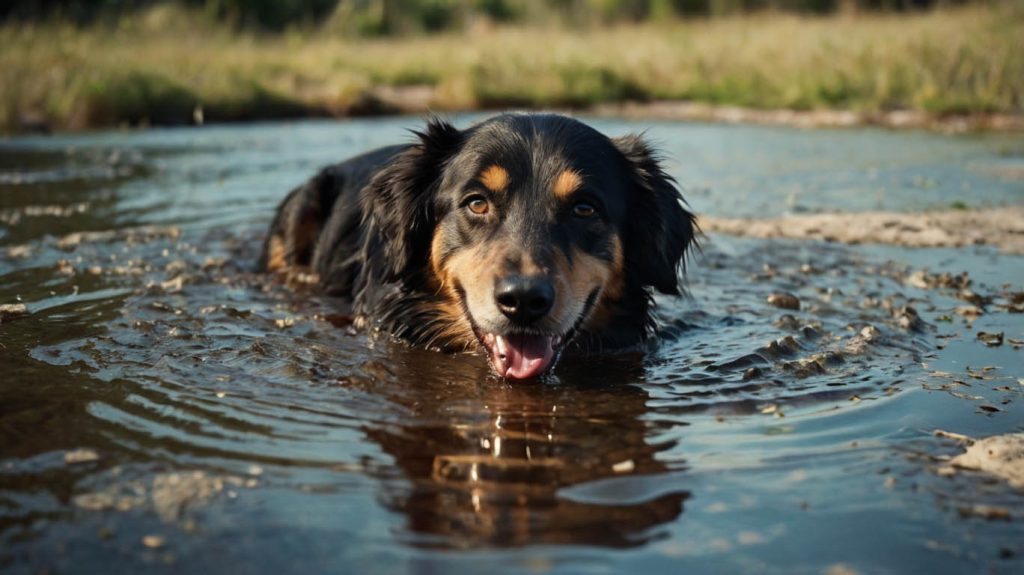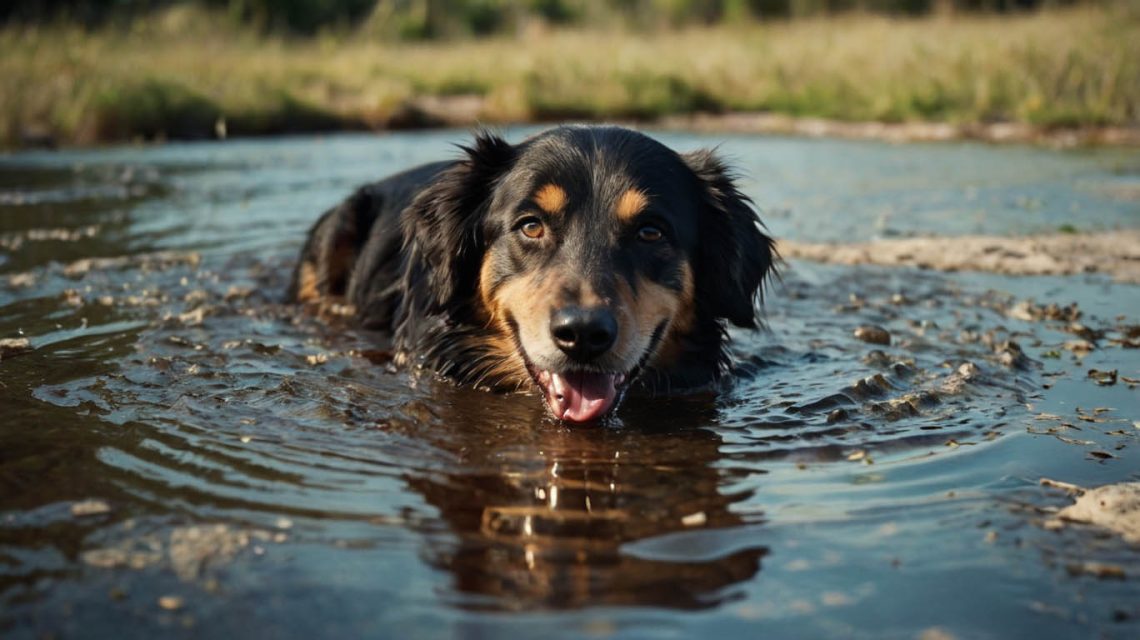Extreme Dehydration in Dogs: Recognizing a Life-or-Death Emergency
Mark watched his senior Golden Retriever, Bailey, lie listlessly on the cool kitchen floor. It had been a hot day, and Bailey, now 11 years old, had seemed a bit sluggish after their short morning walk. Mark figured he was just feeling his age. But as the hours passed, sluggishness turned into something far more frightening. Bailey refused water, his breathing grew shallow, and when Mark gently lifted the skin on his back, it stayed up in a rigid, terrifying tent. He was no longer looking at a tired old friend; he was witnessing the catastrophic signs of extreme dehydration in dogs.
This is not a story about a thirsty dog. This is about a medical crisis. Extreme dehydration in dogs is not a gradual progression from simple dehydration; it is a state of physiological collapse. It’s a condition where the body’s fluid loss is so severe that it can no longer support basic life functions.
Consequently, this guide is not about gentle rehydration tips. It is an emergency manual designed to help you recognize the red alert signs of a life-threatening situation and understand why immediate, aggressive veterinary intervention is the only course of action. Therefore, let’s explore the signs, the consequences, and the necessary response to this critical condition.
What is Extreme Dehydration in Dogs? The Critical Difference
It is vital to distinguish between mild and extreme dehydration. A dog with mild dehydration might be lethargic with sticky gums. A dog with extreme dehydration in dogs, however, is in a state of hypovolemic shock. This means their blood volume has dropped so low that the heart cannot pump effectively, and organs are being starved of oxygen. It is a systemic failure happening in real-time. This is not a “wait and see” situation; it is a “minutes matter” emergency.

The Unmistakable Signs of Extreme Dehydration in Dogs
When dehydration reaches this critical stage, the symptoms are severe and unmistakable. If you see any of the following, you are dealing with a veterinary emergency.
Collapse and Profound Weakness as a Sign of Extreme Dehydration in Dogs
This is the most terrifying sign. The dog may be unable to stand, struggle to lift its head, or be completely unresponsive. This profound weakness is a direct result of circulatory collapse and a lack of energy being supplied to the muscles and brain.
Sunken, Dull Eyes from Extreme Dehydration in Dogs
This is a classic and grave indicator. The fatty tissue and moisture behind the eyeballs are so depleted that the eyes physically sink into their sockets. They will appear dull, hollowed-out, and lifeless. This symptom alone signifies a profound level of fluid loss.
Severe Skin Tenting and a Complete Loss of Elasticity
The skin turgor test becomes definitive in cases of extreme dehydration in dogs. When you lift the skin between the shoulder blades, it will not just return slowly—it may remain standing in a tent for many seconds or not go down at all. This indicates a catastrophic loss of moisture in the body’s tissues.
Pale, White Gums and a Delayed Capillary Refill Time (CRT)
This is a direct sign of shock. The body is shunting blood away from the extremities to protect the vital organs.
- Gum Color: The gums will lose their healthy pink color and appear pale, white, or even bluish-gray.
- Capillary Refill Time (CRT): If you press on the gums, the color will take longer than 3-4 seconds to return, if it returns at all. This confirms that blood circulation is critically impaired.
A Rapid, Weak Pulse and Shallow Breathing
As the heart struggles to pump the thickened, low-volume blood, the pulse becomes rapid but feels weak or “thready.” The breathing may be fast and shallow as the body desperately tries to get more oxygen.

The Life-Threatening Consequences of Extreme Dehydration in Dogs
Understanding what is happening inside your dog’s body underscores the urgency. Extreme dehydration in dogs is not just a lack of water; it is a cascade of organ failure.
Circulatory Collapse (Hypovolemic Shock)
This is the primary event. With insufficient blood volume, blood pressure plummets. Organs do not receive the oxygenated blood they need to survive. This is the state that leads to all other complications and, ultimately, death if not treated.
Acute Kidney Failure
The kidneys are filters that require adequate blood flow and pressure to function. In a state of shock, the kidneys are one of the first organs to be “sacrificed.” They shut down, leading to a buildup of deadly toxins in the bloodstream. Even if the dog survives the initial crisis, they can be left with permanent kidney damage.
Brain Swelling and Neurological Damage
Electrolyte imbalances, particularly sodium, become severe during extreme dehydration in dogs. This can cause brain cells to swell, leading to seizures, coma, and permanent neurological deficits.
What Causes Extreme Dehydration in Dogs?
This level of dehydration is rarely caused by simply not drinking enough water on a hot day. It is almost always secondary to a major medical event.
Severe Acute Illnesses
- Canine Parvovirus: This devastating virus causes severe vomiting and bloody diarrhea, leading to massive fluid loss in a very short time.
- Acute Pancreatitis: Severe inflammation of the pancreas can cause intense vomiting, pain, and fluid shifts within the body.
- Toxin Ingestion: Poisons that cause severe vomiting and diarrhea can rapidly lead to this state.
Environmental Crises Like Heatstroke
Heatstroke is more than just being hot; it’s a condition where the body’s core temperature rises to dangerous levels, causing widespread cellular damage and massive fluid loss through frantic panting. This leads directly to a state of extreme dehydration in dogs.
Uncontrolled Chronic Conditions
Diseases like advanced kidney failure or diabetic ketoacidosis (a severe complication of diabetes) can cause such profound fluid and electrolyte loss that they result in an acute crisis of extreme dehydration.
Why At-Home Treatment for Extreme Dehydration in Dogs Will Fail
This is the most important section of this article. There is NO effective at-home treatment for this condition. Trying to force a dog in this state to drink water is not only futile but also dangerous. They are often too weak to swallow properly, and you risk them aspirating water into their lungs, which can cause pneumonia. Their gut is also in a state of shock and cannot absorb water effectively.
The Only Effective Treatment: Immediate, Aggressive Veterinary Intervention
A dog with extreme dehydration in dogs does not need a bowl of water; it needs a veterinary emergency room. The goal of treatment is to rapidly restore blood volume and reverse shock. This can only be accomplished with:
- Intravenous (IV) Fluids: A catheter is placed directly into a vein, and fluids are administered rapidly into the bloodstream. This is the only way to re-establish blood pressure and perfuse the organs.
- Oxygen Therapy: To help saturate the struggling red blood cells with oxygen.
- Emergency Blood Work: To check organ function, electrolyte levels, and red blood cell counts to guide treatment.
- Treating the Underlying Cause: Once the dog is stabilized, the vet will work to diagnose and treat the root cause, whether it’s parvovirus, heatstroke, or internal bleeding.
Case Study Resolved: Mark and Bailey’s Fight Against Extreme Dehydration in Dogs
Let’s return to Mark and Bailey. Recognizing the gravity of the situation, Mark rushed Bailey to the nearest 24/7 veterinary hospital. The emergency team immediately recognized the signs of hypovolemic shock. They placed an IV catheter and began aggressive fluid resuscitation. Blood work revealed acute kidney failure, a direct consequence of the extreme dehydration in dogs. Bailey spent three days in the ICU on IV fluids. The vet explained that an underlying kidney issue, exacerbated by the hot day, had pushed him into crisis. Because Mark acted immediately, the vets were able to reverse the shock and support Bailey’s kidneys before the damage was irreversible. Bailey’s survival was a direct result of Mark’s understanding that this was a crisis beyond his ability to manage.
Your Dog’s Life Depends On Your Action
Extreme dehydration in dogs is one of the most severe medical emergencies a pet can face. It is a race against time where every minute without professional intervention brings them closer to irreversible organ damage or death.
If your dog is exhibiting any of the signs described in this article—collapse, sunken eyes, severe skin tenting, pale gums—your next action should not be to search for more information. Your only action is to get your dog to a veterinarian immediately. Stop what you are doing and call your emergency vet now. Tell them you are on your way with a dog in shock. This knowledge and your swift action are their only hope.


